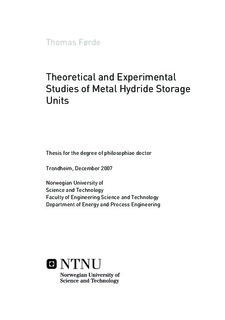| dc.contributor.author | Førde, Thomas | nb_NO |
| dc.date.accessioned | 2014-12-19T11:43:37Z | |
| dc.date.available | 2014-12-19T11:43:37Z | |
| dc.date.created | 2008-03-03 | nb_NO |
| dc.date.issued | 2007 | nb_NO |
| dc.identifier | 123693 | nb_NO |
| dc.identifier.isbn | 978-82-471-5644-5 | nb_NO |
| dc.identifier.uri | http://hdl.handle.net/11250/233351 | |
| dc.description.abstract | The main objective of this work was in experimental studies and modelling of the metal hydride (MH) storage materials and their performances in different types of the MH storage units. The obtained results were further used as a background for the optimisation of the design of the MH storage unit developed within this project, which was thermally connected to a water-cooled proton exchange membrane fuel cell (PEM FC).
The content of the work is divided into three parts:
1. MATERIAL PROPERTIES. Characterisation of the kinetics of hydrogen exchange, thermodynamic (Pressure-Concentration-Temperature isotherms) and micro-structural analyses of the selected for applications alloys.
2. METAL HYDRIDE STORAGE SYSTEMS. The behaviour of the different storage units was studied through experimental work and numerical simulations for the chosen alloys loaded into the units.
3. SYSTEM INTEGRATION. Interactions between the MH storage unit and a fuel cell /electrolyser were studied, through the experimental work and system simulations.
The main results obtained in the work and presented in the thesis are summarised below.
Because of high cycle stability, ability to endure gas impurities and fast kinetics of hydrogen exchange, the AB5-type La0.83Ce0.10Pr0.04Nd0.03Ni4.40Al0.60 alloy was selected as an H storage material. Kinetic studies showed that nucleation and growth or diffusion mechanisms are the rate limiting steps in the interaction of the intermetallic alloy with hydrogen. Enthalpy of formation of the corresponding hydride La0.83Ce0.10Pr0.04Nd0.03Ni4.40Al0.60H5.4 was determined as ΔHabsorption=-27 kJ/mol H2 in the PCT thermodynamic studies. A semi-empirical expression describing the reaction rate of the gas-solid reaction for both absorption and desorption was proposed and experimentally verified. The proposed expression was suitable for use in heat and mass transfer modelling and yielded the values of activation energies and Avrami preexponential factors in good agreement with the available reference data.
Zero-dimensional, one-dimensional and two-dimensional models describing the heat and mass transfer processes in the metal hydride storage units were developed and experimentally verified. Three different MH-storage units filled with the same alloy were tested; the reactors differed in their heat management. The simplest reactor was a cylindrical reactor made of stainless steel with no internal heat exchanger, and with heat transferred through the external walls. The second reactor was made from aluminium and had a replaceable heat exchanger. Two types of heat exchangers were tested; a brush type and a tube type. The third reactor was also made of aluminium and had an internal heat exchanger consisting of a tube with radial fins.
The numerical models were used to identify the parameters controlling the dynamic chargedischarge behaviour of the metal hydride storage units. It was found that both the activation energy and effective thermal conductivity are the most important parameters. Analysis of the experimental data collected during charge and discharge experiments showed that, in addition to the pressure of the hydrogen during loading or release of hydrogen, the overall heat transfer number and heat transfer surface had the most significant effect on the charge and discharge time.
Studies of interaction between three main components of a hydrogen energy system, including an electrolyser, a PEM FC and a MH storage unit, were performed. The zero-dimensional model of the MH store was implemented during a system simulation. The simulations were aimed at considering the case of large fluctuations in energy price, when energy can be bought for a low cost, stored as hydrogen for the required time and sold with a higher price as electricity produced by a FC. The results from the performed simulations and experiments were utilised to design a MH storage unit able to serve a 1.2 kW PEM FC with hydrogen for approximately two hours. Data acquisition and control programs were developed to efficiently operate these two components. | nb_NO |
| dc.language | eng | nb_NO |
| dc.publisher | Fakultet for ingeniørvitenskap og teknologi | nb_NO |
| dc.relation.ispartofseries | Doktoravhandlinger ved NTNU, 1503-8181; 2007:252 | nb_NO |
| dc.title | Theoretical and Experimental Studies of Metal Hybride Storage Units | nb_NO |
| dc.type | Doctoral thesis | nb_NO |
| dc.contributor.department | Norges teknisk-naturvitenskapelige universitet, Fakultet for ingeniørvitenskap og teknologi, Institutt for energi- og prosessteknikk | nb_NO |
| dc.description.degree | PhD i energi- og prosessteknikk | nb_NO |
| dc.description.degree | PhD in Energy and Process Engineering | en_GB |
